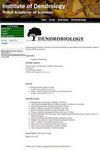四种亲缘关系较近的松树细胞器snp基因分型的SNaPshot测定方法的建立
IF 1.8
4区 农林科学
Q2 FORESTRY
引用次数: 0
摘要
线粒体(mtDNA)和叶绿体(cpDNA)多态性是研究过去人口统计学变化、系统发育和进化的宝贵资源,特别是在森林树种中,这些基因组是单倍体和单亲本转移的。细胞器标记通常使用直接测序或基于pcr的方法单独进行评分,这既耗时又昂贵,特别是在大规模群体遗传学研究中。在这项研究中,我们开发了一种高效、经济的SNaPshot方法,对苏格兰松(Pinus sylvestris L.)和马哥松(Pinus mugo complex)的3个类群等4个近缘松树物种的预选择-mtDNA和cpDNA多态性进行基因分型。我们通过对该物种在欧洲广泛分布的12个种群的样本进行基因分型验证了该方法。结果表明,该方法准确率高,分型成功率达99.7%。这组测定的标记显示出显著的遗传变异。通过多重SNaPshot分析,我们为种内和种间遗传分析提供了一种高效、灵敏的分子工具。该方法可用于近缘种松树细胞器基因组的快速和相对廉价的SNP基因分型。分析的snp可用于研究物种歧视和详细调查其种群历史和结构。由于其众多的优势和高效的基因分型率,SNaPshot方法似乎是研究森林树种遗传组成的一种有价值和实用的资源。特别是,它被证明是有利的群体遗传学。本文章由计算机程序翻译,如有差异,请以英文原文为准。
Development of a SNaPshot assay for the genotyping of organellar SNPs in four closely related pines
Mitochondrial (mtDNA) and chloroplast (cpDNA) polymorphisms are valuable resources to study past demographic changes, phylogenetics and evolution, especially in forest tree species, where these genomes are haploid and uniparentally transferred. The organellar markers were usually scored separately using direct sequencing or PCR-based approaches, which can be time-consuming and expensive, especially in large-scale population genetics research. In this study, we developed an efficient and cost-effective SNaPshot assay for genotyping preselected mtDNA and cpDNA polymorphism in four closely related pine species including Scots pine (Pinus sylvestris L.) and three taxa from the Pinus mugo complex. We validated the method by genotyping the samples derived from 12 populations of the species from their wide geographical distribution range in Europe. The results proved high accuracy of the method with a genotyping success rate of 99.7%. The set of assayed markers shows significant genetic variation. By using multiplex SNaPshot assay, we provided an efficient and sensitive molecular tool for intra- and interspecific genetic analyses. The presented protocol is useful for fast and relatively cheap SNP genotyping of organelle genome of closely related pine species. The assayed SNPs allow studying the species discrimination and detailed investigations of their population history and structure. Given its numerous benefits and efficient genotyping rate, the SNaPshot method appears to be a valuable and practical resource for studying the genetic makeup of forest tree species. Particularly, it proves to be advantageous for population genetics.
求助全文
通过发布文献求助,成功后即可免费获取论文全文。
去求助
来源期刊

Dendrobiology
农林科学-林学
CiteScore
2.20
自引率
11.10%
发文量
17
审稿时长
>12 weeks
期刊介绍:
Dendrobiology publishes original research articles and review articles related to the biology of trees and shrubs.
 求助内容:
求助内容: 应助结果提醒方式:
应助结果提醒方式:


